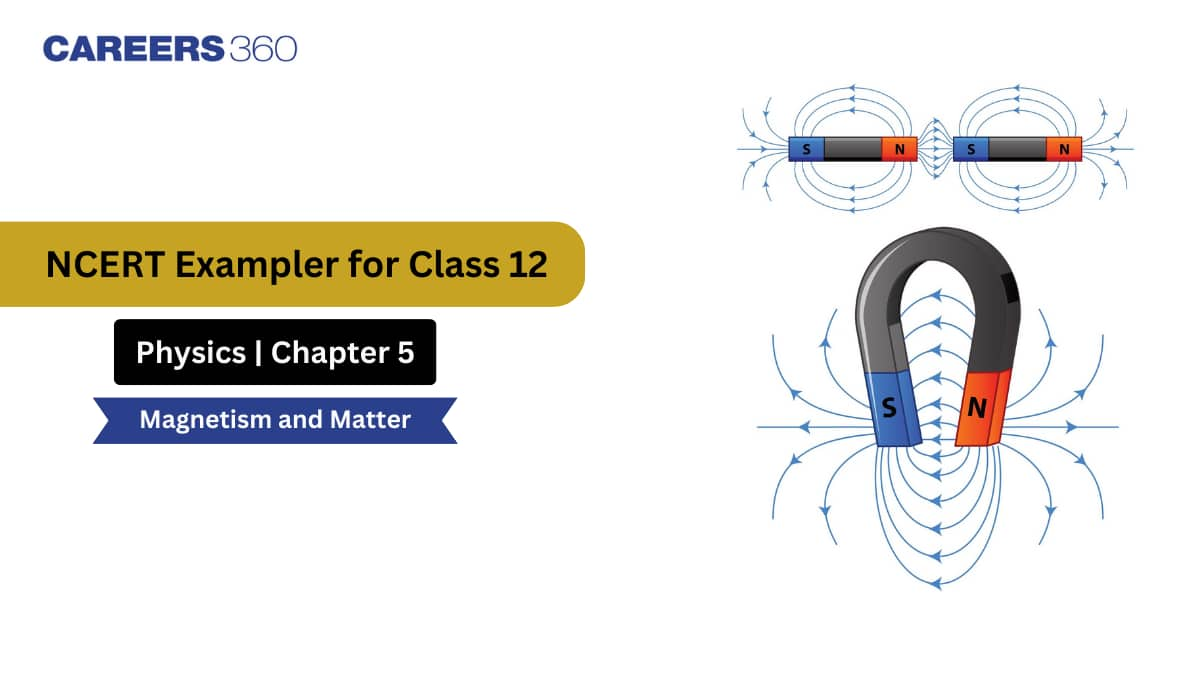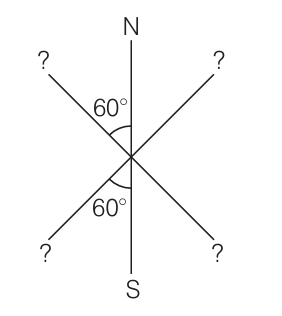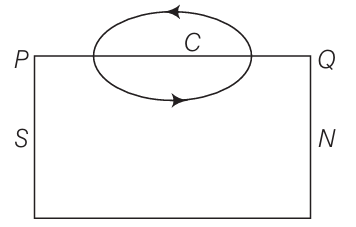Aakash Repeater Courses
Take Aakash iACST and get instant scholarship on coaching programs.
Consider a compass needle which swings in one direction in one location on the earth and another direction in another location. This is a practical case of magnetism and matter which we learn in Chapter 5 of Physics Class 12. Magnetism is involved whether you are using a compass, comparing the response of some materials to magnets, or examining animal or galactic magnetic effects far away.
New: CBSE 12 Class Free Mock Test
Latest: JEE Main high scoring chapters | JEE Main 10 year's papers
Recommended: NEET high scoring chapters

NCERT Exemplar Solutions Physics Class 12 Chapter 5 seeks to find answers to the science of magnetism. It describes why the magnetic field of Earth is not uniform everywhere, considers the magnetic moment of current-carrying loops and solenoids, and also gives what insight it has into the differences in the magnetic properties of different materials. Diamagnetic and paramagnetic as well as ferromagnetic substances are also discussed in the chapter alongside the way in which their internal structures react to external magnetic fields. In order to facilitate preparation of the examination, the exemplar solutions encompass all kinds of questions including multiple-choice (MCQs) to short answer, long answer, and very long answer questions. These overall and easily understandable solutions are perfect in not only preparing for the CBSE board exams but also competitive examinations such as JEE and NEET and provide real practice opportunities to a student through conceptual clarity.
Also check - NCERT Solutions for Class 12 Physics
Question:5.1
A toroid of n turns, mean radius R and cross-sectional radius a carries current I. It is placed on a horizontal table taken as x-y plane. Its magnetic moment m
A. is non-zero and points in the z-direction by symmetry.
B. points along the axis of the toroid
C. is zero, otherwise, there would be a field falling as
D. is pointing radially outwards.
Answer:
The answer is option (C)Question:5.2
The magnetic field of Earth can be modelled by that of a point dipole placed at the center of the Earth. The dipole axis makes an angle of
Then,
A. the declination varies between
B. the least declination is
C. the plane defined by dipole axis and Earth axis passes through Greenwich.
D. declination averaged over Earth must always be negative.
Answer:
The answer is the option (A)
Earth’s magnetic field is similar to a magnetic dipole and we can simulate the nature of Earth’s magnetic field by assuming a dipole at the center of Earth. The axis of the dipole is at an angle of
Question:5.3
In a permanent magnet at room temperature
A. magnetic moment of each molecule is zero.
B. the individual molecules have a non-zero magnetic moment which is all perfectly aligned.
C. domains are partially aligned.
D. domains are all perfectly aligned
Answer:
The answer is the option (D)Question:5.4
Consider the two idealized systems: (i) a parallel plate capacitor with large plates and small separation and (ii) a long solenoid of length L >> R, the radius of the cross-section. In (i) E is ideally treated as a constant between plates and zero outside. In (ii) the magnetic field is constant inside the solenoid and zero outside. These idealized assumptions, however, contradict fundamental laws as below:
A. case (i) contradicts Gauss’s Law for electrostatic fields.
B. case (ii) contradicts Gauss’s Law for magnetic fields.
C. case (i) agrees with
D. case (ii) contradicts
Answer:
The answer is the option (B)Question:5.5
Answer:
The answer is the option (B)
As Curie law explains, we can deduce a formula for the relation between magnetic field induction, temperature and magnetisation.
here
Question:5.6
S is the surface of a lump of magnetic material.
A. Lines of B are necessarily continuous across S.
B. Some lines of B must be discontinuous across S.
C. Lines of H are necessarily continuous across S.
D. Lines of H cannot all be continuous across S.
Answer:
The correct answer are the options (A,D)Question:5.7
The primary origin(s) of magnetism lies in
A. atomic currents.
B. Pauli exclusion principle.
C. polar nature of molecules.
D. intrinsic spin of the electron.
Answer:
The correct answer are the options (A,D)Question:5.8
A long solenoid has 1000 turns per meter and carries a current of 1 A. It has a soft iron core of
A. The H field in the solenoid is (nearly) unchanged, but the B field decreases drastically.
B. The H and B fields in the solenoid are nearly unchanged.
C. The magnetization in the core reverses direction.
D. The magnetization in the core diminishes by a factor of about 108
Answer:
The correct answer are the options (A,D)Question:5.9
The essential difference between electrostatic shielding by a conducting shell and magnetostatic shielding is due to
A. electrostatic field lines can end on charges and conductors have free charges.
B. lines of B can also end, but conductors cannot end them.
C. lines of B cannot end on any material, and perfect shielding is not possible.
D. shells of high permeability materials can be used to divert lines of B from the interior region.
Answer:
The correct answer is the options (A,C,D)Question:5.10
Let the magnetic field on Earth be modelled by that of a point magnetic dipole at the center of Earth. The angle of dip at a point on the geographical equator
A. is always zero.
B. can be zero at specific points.
C. can be positive or negative.
D. is bounded.
Answer:
The correct answer are the options (B,C,D)
Earth’s magnetic dipole is at an angle of
Question:5.11
Answer:
Magnetic moment of electron and proton are:Question:5.12
Answer:
Question:5.14
Answer:
Diamagnetism occurs due to electron’s motion in its orbit and the external magnetic field being opposite to each other, making the net magnetism zero. Temperature does not impact the susceptibility of diamagnetism.Question:5.15
Answer:
Both liquid nitrogen and the superconducting material are diamagnetic in nature. This does not change even when the superconducting material is dipped into liquid nitrogen. In presence of an external magnetic field, superconducting material will be repelled opposite to the direction of the magnetic field.
Question:5.16
Answer:

Question:5.17

Answer:
The system is considered to be in state of stable equilibrium if both net force and net torque on system is 0. The only way to make such a system feasible is to have the following configuration:
Question:5.19
Answer:
Time period in this type of S.H.M is
where, T=time period
I=moment of Inertia
m=mass of magnet
B=magnetic field
When the magnet is cut into two equal pieces, perpendicular to length the M.O.I of each piece of magnet about an axis perpendicular to the length passing through its centre is
Magnetic dipole moment
Its time period of oscillation is
Question:5.20
Answer:
Consider a magnetic field line of B through the bar magnet as given in the figure below.

The magnetic field line of
Let
We know that the angle between
i.e.,
Hence, the lines of B must run from south pole(S) to north pole (
According to Ampere's law,
(i.e., negative)
It will be so if angle between
Question:5.21
Answer:
Assume the x-z plane (shown below). All points from P to Q lie on the axial line NS placed at the origin.
The magnetic field at a distance r is
Along z-axis from P to Q
ii Along the quarter circle QS (radius R)
Consider point A to lie on the equatorial line of magnetic dipole of moment M sinθ.
Magnetic field at A is
iii Along x-axis over the path ST, consider the figure given below
From the figure, every point lies on the equatorial line of the magnetic dipole.
Magnetic field induction at a point distance x from the dipole is
iv Along the quarter circle TP of radius a.
Let's consider the figure given below
From case ii we get line integral of B along the quarter circle TP of radius a
is circular arc TP.
Question:5.22
Answer:
As I and H both have same units and dimensions, hence χ has no dimensions.
Here, χ is related with e, m, v, R and
From Biot-Savart'slaw,
Dimensions of
where Q is the dimension of charge
As χ is dimensionless, it should have no involvement of charge Q in its dimensional formula.
It will be so if μ0 and e together should have the value
Let
where a, b ,c are the power of m,v and R respectively
Equating the powers we get 0=1+a
a=-1
0=1+b+c
0=-b
b=0
1+0+c=0
c=-1
Putting values in equation i we get
Here,
Question:5.23
Assume the dipole model for earth’s magnetic field B which is given by BV = vertical component of magnetic field
BH = Horizontal component of magnetic field
Find loci of points for which (i) B is minimum; (ii) dip angle is zero; and (iii) dip angle is
Answer:
(c)
Angle of dip
Thus,
Question:5.24
Answer:

Question:5.25
Answer:
For
Below are the main subtopics covered in NCERT Exemplar Class 12 Physics Chapter 5 – Magnetism and Matter, which explore the laws, effects, and real-world applications of magnetism in materials and the Earth’s magnetic field.
Take Aakash iACST and get instant scholarship on coaching programs.
These questions are solved in the most simple and explanative way so that one can grasp the topic. This will help in understanding the basics and how to solve questions in exams.
This chapter covers various important topics like properties of bar magnet, diamagnetism, ferromagnetism and paramagnetism and earths magnetism etc. These topics are highly crucial from both boards and entrance exam POV.
Magnetic materials are used in power generation, digital devices, medical tools, sensors, data storage devices.
Earth’s magnetic field is generated by the movement of molten iron in its core. It varies from place to place due to the irregular structure of the Earth and local magnetic materials.
Magnetic materials are substances that respond to magnetic fields. They are classified as diamagnetic, paramagnetic, and ferromagnetic based on their behavior in a magnetic field.
Application Date:24 July,2025 - 23 August,2025
Application Date:24 July,2025 - 23 August,2025
Changing from the CBSE board to the Odisha CHSE in Class 12 is generally difficult and often not ideal due to differences in syllabi and examination structures. Most boards, including Odisha CHSE , do not recommend switching in the final year of schooling. It is crucial to consult both CBSE and Odisha CHSE authorities for specific policies, but making such a change earlier is advisable to prevent academic complications.
Hello there! Thanks for reaching out to us at Careers360.
Ah, you're looking for CBSE quarterly question papers for mathematics, right? Those can be super helpful for exam prep.
Unfortunately, CBSE doesn't officially release quarterly papers - they mainly put out sample papers and previous years' board exam papers. But don't worry, there are still some good options to help you practice!
Have you checked out the CBSE sample papers on their official website? Those are usually pretty close to the actual exam format. You could also look into previous years' board exam papers - they're great for getting a feel for the types of questions that might come up.
If you're after more practice material, some textbook publishers release their own mock papers which can be useful too.
Let me know if you need any other tips for your math prep. Good luck with your studies!
It's understandable to feel disheartened after facing a compartment exam, especially when you've invested significant effort. However, it's important to remember that setbacks are a part of life, and they can be opportunities for growth.
Possible steps:
Re-evaluate Your Study Strategies:
Consider Professional Help:
Explore Alternative Options:
Focus on NEET 2025 Preparation:
Seek Support:
Remember: This is a temporary setback. With the right approach and perseverance, you can overcome this challenge and achieve your goals.
I hope this information helps you.
Hi,
Qualifications:
Age: As of the last registration date, you must be between the ages of 16 and 40.
Qualification: You must have graduated from an accredited board or at least passed the tenth grade. Higher qualifications are also accepted, such as a diploma, postgraduate degree, graduation, or 11th or 12th grade.
How to Apply:
Get the Medhavi app by visiting the Google Play Store.
Register: In the app, create an account.
Examine Notification: Examine the comprehensive notification on the scholarship examination.
Sign up to Take the Test: Finish the app's registration process.
Examine: The Medhavi app allows you to take the exam from the comfort of your home.
Get Results: In just two days, the results are made public.
Verification of Documents: Provide the required paperwork and bank account information for validation.
Get Scholarship: Following a successful verification process, the scholarship will be given. You need to have at least passed the 10th grade/matriculation scholarship amount will be transferred directly to your bank account.
Scholarship Details:
Type A: For candidates scoring 60% or above in the exam.
Type B: For candidates scoring between 50% and 60%.
Type C: For candidates scoring between 40% and 50%.
Cash Scholarship:
Scholarships can range from Rs. 2,000 to Rs. 18,000 per month, depending on the marks obtained and the type of scholarship exam (SAKSHAM, SWABHIMAN, SAMADHAN, etc.).
Since you already have a 12th grade qualification with 84%, you meet the qualification criteria and are eligible to apply for the Medhavi Scholarship exam. Make sure to prepare well for the exam to maximize your chances of receiving a higher scholarship.
Hope you find this useful!
hello mahima,
If you have uploaded screenshot of your 12th board result taken from CBSE official website,there won,t be a problem with that.If the screenshot that you have uploaded is clear and legible. It should display your name, roll number, marks obtained, and any other relevant details in a readable forma.ALSO, the screenshot clearly show it is from the official CBSE results portal.
hope this helps.

Take Aakash iACST and get instant scholarship on coaching programs.

This ebook serves as a valuable study guide for NEET 2025 exam.

This e-book offers NEET PYQ and serves as an indispensable NEET study material.

As per latest syllabus. Physics formulas, equations, & laws of class 11 & 12th chapters
As per latest syllabus. Chemistry formulas, equations, & laws of class 11 & 12th chapters
As per latest 2024 syllabus. Study 40% syllabus and score upto 100% marks in JEE